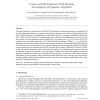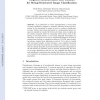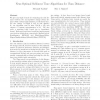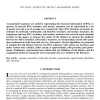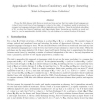PR
2011
14 years 1 months ago
2011
This paper introduces a simple Sum-over-Paths (SoP) formulation of string edit distances accounting for all possible alignments between two sequences, and extends related previous...
PKDD
2010
Springer
14 years 4 months ago
2010
Springer
As an alternative to vector representations, a recent trend in image classification suggests to integrate additional structural information in the description of images in order to...
SODA
2010
ACM
14 years 4 months ago
2010
ACM
We give near-tight bounds for estimating the edit distance between two non-repetitive strings (Ulam distance) with constant approximation, in sub-linear time. For two strings of l...
RSA
2008
14 years 5 months ago
2008
For a graph property P, the edit distance of a graph G from P, denoted EP (G), is the minimum number of edge modifications (additions or deletions) one needs to apply to G in orde...
JCB
2002
14 years 6 months ago
2002
Arc-annotated sequences are useful in representing the structural information of RNA sequences. In general, RNA secondary and tertiary structures can be represented as a set of ne...
ISCI
2007
14 years 6 months ago
2007
Graph matching and graph edit distance have become important tools in structural pattern recognition. The graph edit distance concept allows us to measure the structural similarit...
PR
2006
14 years 6 months ago
2006
A common approach in structural pattern classification is to define a dissimilarity measure on patterns and apply a distance-based nearest-neighbor classifier. In this paper, we i...
IANDC
2007
14 years 6 months ago
2007
The edit distance (or Levenshtein distance) between two words is the smallest number of substitutions, insertions, and deletions of symbols that can be used to transform one of the...
HEURISTICS
2007
14 years 6 months ago
2007
In this paper, we develop and discuss several distance measures for permutation type representations of solutions of combinatorial optimisation problems. The problems discussed in...
JIIS
2008
14 years 6 months ago
2008
We use the Edit distance with Moves on words and trees and say that two regular (tree) languages are -close if every word (tree) of one language is -close to the other. A transduc...
